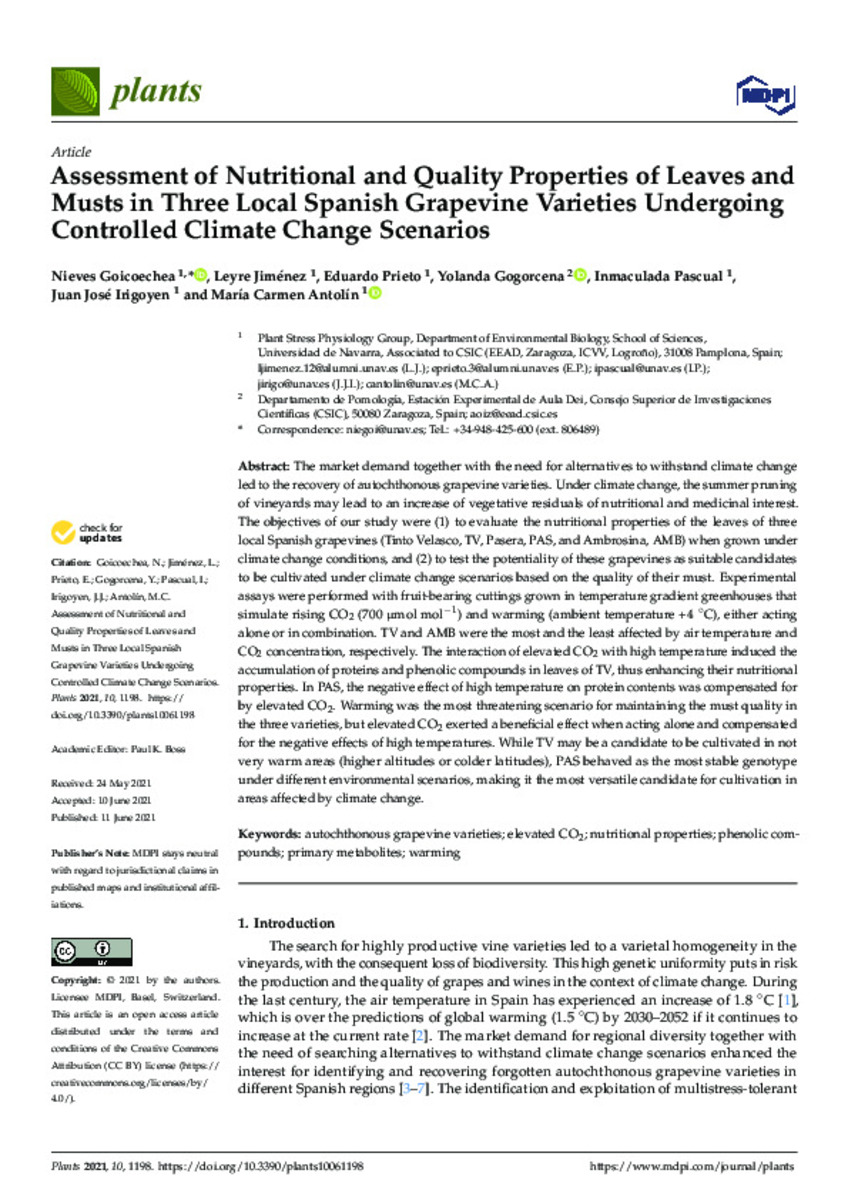Full metadata record
| DC Field | Value | Language |
|---|---|---|
| dc.creator | Goicoechea, N. (Nieves) | - |
| dc.creator | Jiménez, L. (Leire) | - |
| dc.creator | Prieto, E. (Eduardo) | - |
| dc.creator | Gogorcena, Y. (Yolanda) | - |
| dc.creator | Pascual, I. (Inmaculada) | - |
| dc.creator | Irigoyen, J.J. (Juan Jose) | - |
| dc.creator | Antolin-Bellver, M.C. (M. Carmen) | - |
| dc.date.accessioned | 2023-12-18T08:53:12Z | - |
| dc.date.available | 2023-12-18T08:53:12Z | - |
| dc.date.issued | 2021-06-11 | - |
| dc.identifier.citation | Goicoechea, N.; Jiménez, L.; Prieto, E.; Gogorcena, Y.; Pascual, I.; Irigoyen, J.J.; Antolín, M.C. Assessment of Nutritional and Quality Properties of Leaves and Musts in Three Local Spanish Grapevine Varieties Undergoing Controlled Climate Change Scenarios. Plants 2021, 10, 1198 | es_ES |
| dc.identifier.issn | 2223-7747 | - |
| dc.identifier.uri | https://hdl.handle.net/10171/68071 | - |
| dc.description.abstract | The market demand together with the need for alternatives to withstand climate change led to the recovery of autochthonous grapevine varieties. Under climate change, the summer pruning of vineyards may lead to an increase of vegetative residuals of nutritional and medicinal interest. The objectives of our study were (1) to evaluate the nutritional properties of the leaves of three local Spanish grapevines (Tinto Velasco, TV, Pasera, PAS, and Ambrosina, AMB) when grown under climate change conditions, and (2) to test the potentiality of these grapevines as suitable candidates to be cultivated under climate change scenarios based on the quality of their must. Experimental assays were performed with fruit-bearing cuttings grown in temperature gradient greenhouses that simulate rising CO2 (700 µmol mol−1 ) and warming (ambient temperature +4 ◦C), either acting alone or in combination. TV and AMB were the most and the least affected by air temperature and CO2 concentration, respectively. The interaction of elevated CO2 with high temperature induced the accumulation of proteins and phenolic compounds in leaves of TV, thus enhancing their nutritional properties. In PAS, the negative effect of high temperature on protein contents was compensated for by elevated CO2 . Warming was the most threatening scenario for maintaining the must quality in the three varieties, but elevated CO2 exerted a beneficial effect when acting alone and compensated for the negative effects of high temperatures. While TV may be a candidate to be cultivated in not very warm areas (higher altitudes or colder latitudes), PAS behaved as the most stable genotype under different environmental scenarios, making it the most versatile candidate for cultivation in areas affected by climate change. | es_ES |
| dc.language.iso | eng | es_ES |
| dc.relation | EUROPEAN REGIONAL DEVELOPMENT FUND | es_ES |
| dc.rights | info:eu-repo/semantics/openAccess | es_ES |
| dc.subject | Autochthonous grapevine varieties | es_ES |
| dc.subject | Elevated CO2 | es_ES |
| dc.subject | Nutritional properties | es_ES |
| dc.subject | Phenolic compounds | es_ES |
| dc.subject | Primary metabolites | es_ES |
| dc.subject | Warming | es_ES |
| dc.subject | Materias Investigacion::Ciencias de la vida::Biología | es_ES |
| dc.title | Assessment of nutritional and quality properties of leaves and musts in three local spanish grapevine varieties undergoing controlled climate change scenarios | es_ES |
| dc.type | info:eu-repo/semantics/article | es_ES |
| dc.description.note | This research was funded by FUNDACIÓN UNIVERSITARIA DE NAVARRA (2018). Partial support was obtained from the SPANISH STATE RESEARCH AGENCY (AEI) cofinanced with the EUROPEAN REGIONAL DEVELOPMENT FUND (FEDER) (project AGL2017-83358-R to Y.G.; AEI/FEDER, UE), and the ARAGÓN GOVERNMENT (Group A09-20R). | es_ES |
| dc.editorial.note | CC BY 4.0 | es_ES |
| dc.identifier.doi | 10.3390/plants10061198 | - |
| dc.identifier.pmid | 34208410 | - |
Files in This Item:
Statistics and impact
Items in Dadun are protected by copyright, with all rights reserved, unless otherwise indicated.






